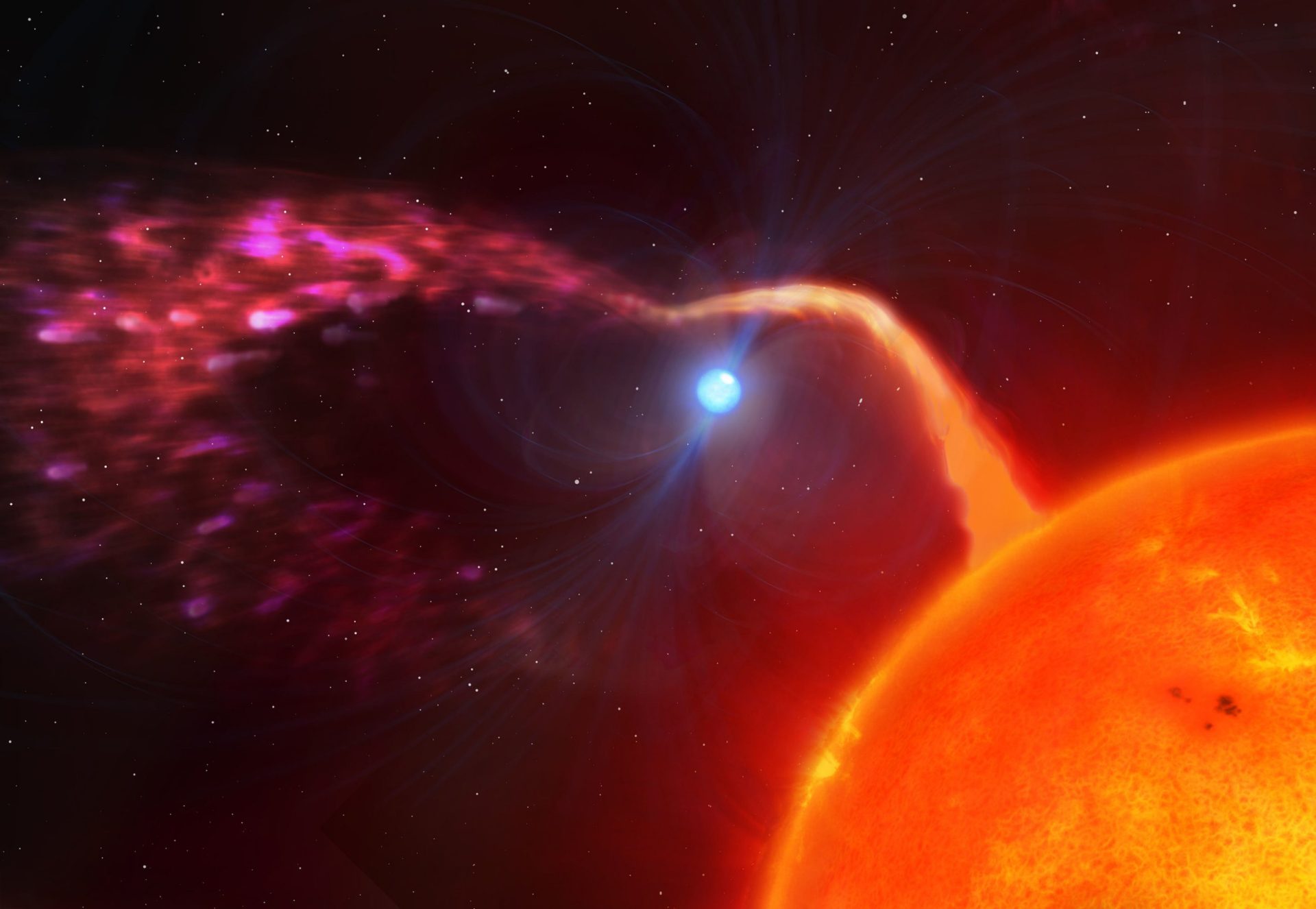White dwarf pulsars include a rapidly spinning, burnt-out stellar remnant called a white dwarf, which lashes a companion red dwarf with powerful beams of electrical particles and radiation, causing the entire system to brighten and fade dramatically over regular intervals. This is owing to strong magnetic fields, but astronomers are unsure what causes them. A key theory which explains the strong magnetic fields is the dynamo model — that white dwarfs have dynamos in their core, as does the Earth, but much more powerful. But for this theory to be tested, astronomers needed to search for other white dwarf pulsars to see if their predictions held true.

This artist’s impression shows AR Scorpii. In this unique double star a rapidly spinning white dwarf star (right) powers electrons up to almost the speed of light. These high energy particles release blasts of radiation that lash the companion red dwarf star (left) and cause the entire system to pulse dramatically every 1.97 minutes with radiation ranging from the ultraviolet to radio. Image credit: M. Garlick / University of Warwick / ESO.
“White dwarf stars are the most common stellar fossils,” said University of Warwick astronomer Ingrid Pelisoli and her colleagues.
“When in binaries, they make up the dominant form of compact object binary within the Milky Way Galaxy and can offer insight into different aspects of binary formation and evolution.”
“One of the most remarkable white dwarf binary systems identified to date is AR Scorpii.”
“AR Scorpii is composed of a red dwarf and a rapidly spinning white dwarf in a 3.56 h orbit.”
“It shows pulsed emission with a period of 1.97 min over a broad range of wavelengths, which led to it being known as a white dwarf pulsar.”
“Both the pulse mechanism and the evolutionary origin of AR Scorpii provide challenges to theoretical models.”

The newly-discovered white dwarf pulsar, J191213.72-441045.1 (J1912-4410 for short), is a sibling of AR Scorpii.
It resides 773 light-years away from Earth, has a size similar to the Earth, but a mass at least as large as the Sun.
It harbors a white dwarf in a 4.03 h orbit with a red dwarf and exhibits pulsed emission with a period of 5.30 min.
White dwarfs begin their lives at extremely hot temperatures before cooling down over billions of years, and the low temperature of J1912-4410 points to an advanced age.
“The origin of magnetic fields is a big open question in many fields of astronomy, and this is particularly true for white dwarf stars,” Dr. Pelisoli said.
“The magnetic fields in white dwarfs can be more than a million times stronger than the magnetic field of the Sun, and the dynamo model helps to explain why.”
“The discovery of J1912-4410 provided a critical step forward in this field.”
“We used data from a few different surveys to find candidates, focusing on systems that had similar characteristics to AR Scorpii,” she said.

“We followed up any candidates with ULTRACAM, which detects the very fast light variations expected of white dwarf pulsars.”
“After observing a couple dozen candidates, we found one that showed very similar light variations to AR Scorpii.”
“Our follow-up campaign with other telescopes revealed that every five minutes or so, this system sent a radio and X-ray signal in our direction.”
“This confirmed that there are more white dwarf pulsars out there, as predicted by previous models.”
“There were other predictions made by the dynamo model, which were confirmed by the discovery of J1912-4410.”
“Due to their old age, the white dwarfs in the pulsar system should be cool.”
“Their companions should be close enough that the gravitational pull of the white dwarf was in the past strong enough to capture mass from the companion, and this causes them to be fast spinning.”
“All of those predictions hold for the new pulsar found: the white dwarf is cooler than 13,000 K, spins on its axis once every five minutes, and the gravitational pull of the white dwarf has a strong effect in the companion.”
“This research is an excellent demonstration that science works — we can make predictions and put them to test, and that is how any science progresses.”
The discovery is reported in a paper in the journal Nature Astronomy.





